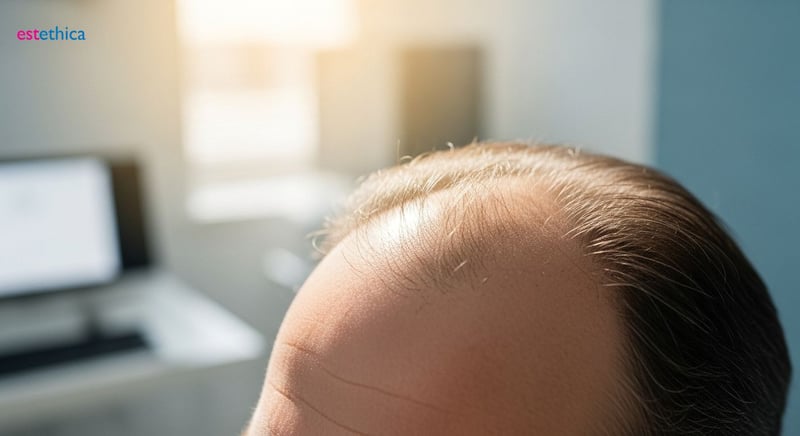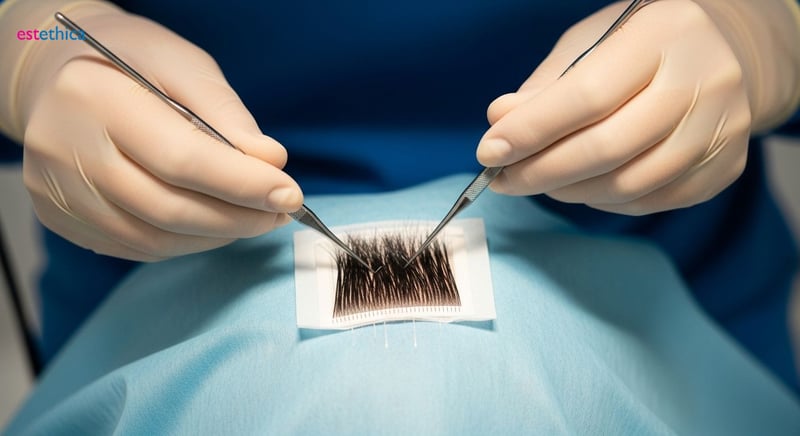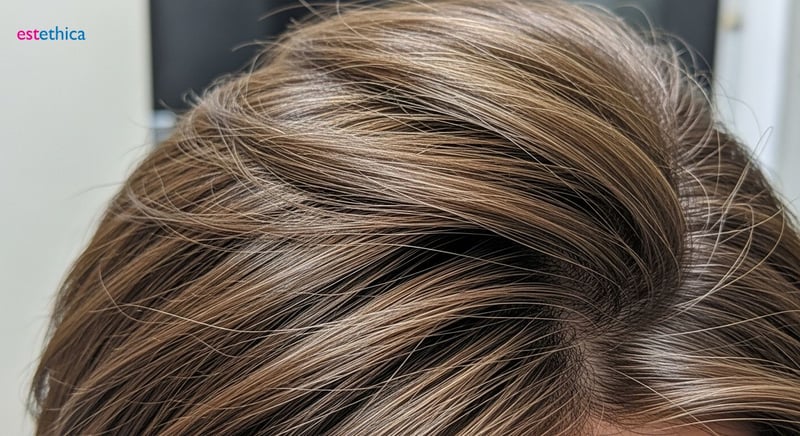Hair Loss Reversed: Your Guide to Hair Transplantation Success
Achieve hair restoration success with estethica's expert hair transplant techniques and comprehensive aftercare solutions.
Hair loss can be a deeply personal concern, impacting both your appearance and self-esteem. In this guide, we delve into the root causes of hair loss and explore cutting-edge hair transplant techniques. Discover the journey of hair restoration, from preparation to recovery, and learn about the longevity and maintenance of your new hair. Harness the expertise of estethica, a leader in aesthetic services, to achieve successful hair transplantation outcomes.
Understanding Hair Loss: What's Causing Yours?
Identifying the Culprits of Hair Thinning
Hair loss affects millions globally and can stem from genetics, hormonal shifts, medical conditions, and lifestyle habits. Pinpointing the exact cause is crucial for effective hair restoration strategies. While some individuals observe gradual thinning, others encounter sudden, noticeable loss. A significant number of men experience hair thinning by age 50. Common causes include androgenetic alopecia, stress, poor nutrition, and medical treatments. Identifying your specific trigger will tailor the most appropriate strategy for hair transplant or alternative treatments. estethica Global specialists can help you understand all aspects of your hair.
Factors Influencing Hair Loss
- Genetic Predisposition: Family history often dictates susceptibility to conditions like androgenetic alopecia, impacting hair follicle sensitivity to hormones.
- Hormonal Imbalances: Fluctuations in hormones, especially during menopause or thyroid disorders, can disrupt the hair growth cycle and lead to thinning.
- External Stressors: Significant stress, whether physical or emotional, can trigger telogen effluvium, causing temporary but noticeable hair loss treatment.
At estethica Global, our consultants provide detailed information about all procedures, including the intricacies of FUE hair transplant and other advanced techniques.
Navigating Treatment Options
Once the cause is identified, various treatment options can be explored. These range from medical treatments like minoxidil and finasteride to surgical solutions such as hair transplant. For instance, androgenetic alopecia, a common genetic condition, affects over 50% of men by age 50 and can be managed with medications or surgical hair restoration. Other options, like scalp micropigmentation, provide non-surgical alternatives. estethica Global offers state-of-the-art hair transplant clinic services for those considering surgical solutions.
Steps to Comprehensive Hair Evaluation
- Consultation and Examination: A thorough examination by a specialist at estethica Global to assess the extent and pattern of hair loss, including follicle health.
- Diagnostic Testing: Blood tests and scalp biopsies to rule out underlying medical conditions contributing to the hair loss.
- Personalized Treatment Plan: Development of a customized plan that might involve medical treatments, lifestyle adjustments, or considering procedures like hair transplant.

Top Hair Transplant Techniques: FUT vs. FUE Explained
Comparing FUT and FUE Methods for Hair Restoration
Hair transplantation approaches have significantly improved, providing effective solutions for various types of hair loss treatment. Follicular Unit Transplantation (FUT) and Follicular Unit Extraction (FUE) stand out as prominent techniques. At estethica, advanced methods like Sapphire FUE and DHI enhance results, minimizing visible scarring while maximizing natural appearance. FUE involves removing individual follicles, ensuring a faster recovery for patients, whereas FUT allows for harvesting a higher number of follicles in one session. Choosing the appropriate method relies heavily on factors like the extent of hair loss, the availability of donor hair, and individual goals.
Key Considerations for FUT and FUE
- FUT (Follicular Unit Transplantation): Involves removing a strip of scalp to harvest follicles, suitable for extensive hair restoration needs. The strip is typically taken from the back of the head, where hair is denser. estethica Global ensures minimal scarring with advanced closure techniques.
- FUE (Follicular Unit Extraction): Extracts individual follicles directly from the scalp, ideal for those preferring less invasive options. Sapphire FUE, available at estethica, uses special blades for precision.
- Recovery and Results: FUE generally offers a quicker recovery, while FUT may provide a higher yield of follicles. Both techniques aim to deliver natural-looking results, enhancing your overall appearance.
The Process of hair transplant; from Consultation to Completion
- Initial Consultation: Assessment of hair loss extent and discussion of patient expectations at estethica Global.
- Procedure Execution: Performing either FUT or FUE based on the agreed plan, utilizing advanced technologies for optimal follicle placement and survival.
- Post-operative Care: Providing detailed aftercare instructions and support to ensure proper healing and the best possible outcome. estethica Global offers ongoing support to help patients achieve desired results.

The Hair Restoration Journey: Before, During, and After
Essential Stages of hair restoration
Undergoing a hair restoration procedure involves distinct phases, each critical for optimal outcomes. Initially, in-depth consultations with hair transplant specialists are conducted to assess needs and set realistic expectations. During the hair transplant, patient comfort is maintained using advanced sedation techniques. Post-operatively, estethica provides superior aftercare, employing innovative therapies such as laser treatments and PRP to stimulate hair follicle strength and promote robust growth. Effective hair loss treatment relies on a strategic approach, tailored to individual needs and leveraging the latest advancements in technology and care.
Key Steps in a Hair Transplant Journey
- Initial Consultation: Comprehensive evaluation to determine suitability for a hair transplant, including assessing hair loss patterns, donor availability, and discussing expected outcomes.
- Surgical Procedure: Utilizing advanced techniques like Sapphire FUE or DHI for precise follicle placement and natural-looking results.
- Post-operative Support: Offering extensive aftercare, including laser and PRP treatments, to support healing and enhance graft survival, ensuring long-term satisfaction.
Innovative Aftercare Treatments for Hair Growth
- Laser Therapy: Stimulates blood flow to the scalp, promoting hair follicle activity and accelerating hair growth after a hair transplant.
- PRP Therapy: Utilizes the patient's own platelet-rich plasma to encourage follicle regeneration and improve hair density.
- Personalized Care Plans: Tailored strategies to meet individual recovery needs, ensuring the best possible results and comfort throughout the healing process at estethica Global.

Is Hair Transplant Permanent? Longevity and Maintenance Tips
Maximizing the Lifespan of Your Hair Transplant
The longevity of a hair transplant is a primary concern for many patients. While the transplanted follicles are genetically resistant to hair loss, their long-term health hinges on various factors. The success of a hair transplant largely depends on consistent post-operative care and adherence to guidelines provided by your surgical team. Genetics also play a crucial role; individuals with strong hereditary hair density often see more durable results. Regular check-ups with hair restoration specialists are essential to monitor hair health. estethica emphasizes patient education, equipping individuals with information of Sapphire FUE necessary for preserving the aesthetic outcome of your procedure.
Essential Factors for Sustaining Hair Transplant Results
- Consistent Scalp Care: Regular, gentle cleansing to avoid buildup that can choke follicles. Using doctor-recommended shampoos keeps the scalp healthy.
- Nutritional Balance: A diet rich in vitamins and minerals vital for hair health, such as iron, zinc, and biotin, ensures stronger hair growth. Ensuring optimal levels through balanced meals supports follicle strength and vitality.
- Protection from Environmental Stressors: Shielding hair from excessive sun, pollution, and harsh chemicals preserves the integrity of transplanted grafts. Using protective hair products minimizes damage.
How To Make Hair Transplant Look Natural?
- Proper Post-Operative Care: Adhering to all aftercare instructions is vital for graft survival.
- Choosing the Right Clinic: Select a clinic known for using advanced techniques. estethica is known for employing the latest FUE hair transplant methods, which help ensure natural-looking results through precise follicle placement and minimal scarring.
- Realistic Expectations: Understanding the limitations and potential outcomes of the procedure is important for satisfaction. A successful hair transplant enhances appearance with results that blend naturally with your existing hair.
Transform Your Look: The Ultimate Guide to Hair Transplant
Advanced Sapphire FUE Techniques for Natural Hair Restoration
Individualized Aftercare for Enhanced Hair Growth and Graft Survival
Frequently Asked Questions
What are the primary causes of hair loss and how can a hair transplant help?
What are the key differences between FUT and FUE hair transplant techniques?
What can I expect during the hair restoration journey, from the initial consultation to the aftercare?
How can I ensure the longevity and maintain the results of my hair transplant?
Achieve your aesthetic goals with estethica's personalized treatment plans and expert care.
📞 Book Your Free Consultation!